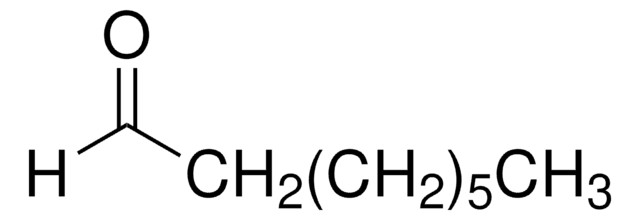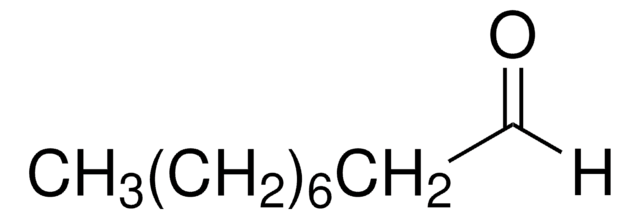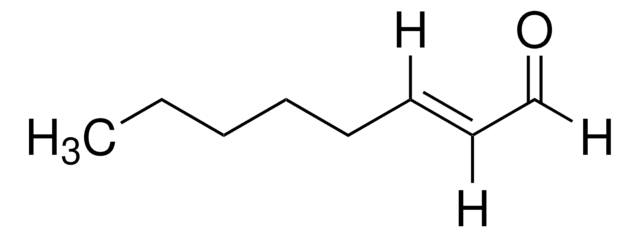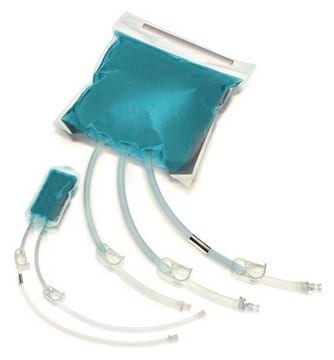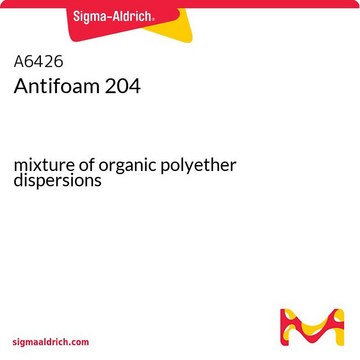W279706
Octanal
≥95%, FCC, FG
Synonym(s):
Aldehyde C8, Caprylic aldehyde, Octyl aldehyde
About This Item
Fragrance grade
Halal
Kosher
Recommended Products
biological source
synthetic
Quality Level
grade
FG
Fragrance grade
Halal
Kosher
Agency
follows IFRA guidelines
meets purity specifications of JECFA
reg. compliance
EU Regulation 1223/2009
EU Regulation 1334/2008 & 178/2002
FCC
FDA 21 CFR 172.515
vapor pressure
2 mmHg ( 20 °C)
850 mmHg ( 25 °C)
850 mmHg ( 25 °C)
Assay
≥95%
refractive index
n20/D 1.421 (lit.)
bp
171 °C (lit.)
mp
12-15 °C (lit.)
density
0.82 g/mL at 25 °C (lit.)
application(s)
flavors and fragrances
Documentation
see Safety & Documentation for available documents
food allergen
no known allergens
fragrance allergen
no known allergens
Organoleptic
fatty; green; orange; waxy; citrus
SMILES string
[H]C(=O)CCCCCCC
InChI
1S/C8H16O/c1-2-3-4-5-6-7-8-9/h8H,2-7H2,1H3
InChI key
NUJGJRNETVAIRJ-UHFFFAOYSA-N
Looking for similar products? Visit Product Comparison Guide
Related Categories
Signal Word
Warning
Hazard Statements
Precautionary Statements
Hazard Classifications
Aquatic Chronic 3 - Eye Irrit. 2 - Flam. Liq. 3 - Skin Irrit. 2
Storage Class Code
3 - Flammable liquids
WGK
WGK 2
Flash Point(F)
125.6 °F - closed cup
Flash Point(C)
52 °C - closed cup
Personal Protective Equipment
Choose from one of the most recent versions:
Already Own This Product?
Find documentation for the products that you have recently purchased in the Document Library.
Customers Also Viewed
Protocols
-3,7-Dimethyl-2,6-octadien-1-ol; Neral; Geraniol; Geranial; Undecanal; Citronellyl acetate; Neryl acetate; 3,7-Dimethyl-2,6-octadienyl acetate; 1-Tetradecene; Tetradecane; α-Bisabolol
Fast GC analysis of sweet orange essential oil in hexane. Key components identified includes: β-Farnesene; α-Huµlene; Germacrene D; (+)-Valencene; Bicyclogermacrene; (+)-δ-Cadinene
Global Trade Item Number
| SKU | GTIN |
|---|---|
| W279706-1KG | |
| W279706-1KG-K | 4061837516825 |
| W279706-20KG-K | 4061837835162 |
| W279706-8KG-K | |
| W279706-SAMPLE-K | 4061837516832 |
| W279706-20KG | |
| W279706-4KG | |
| W279706-4KG-K | 4061837835179 |
| W279706-800G | |
| W279706-8KG | |
| W279706-SAMPLE |
Our team of scientists has experience in all areas of research including Life Science, Material Science, Chemical Synthesis, Chromatography, Analytical and many others.
Contact Technical Service